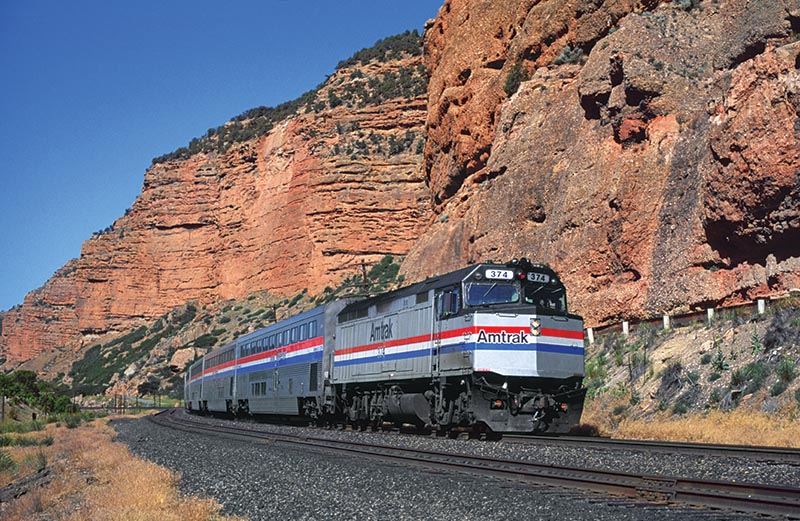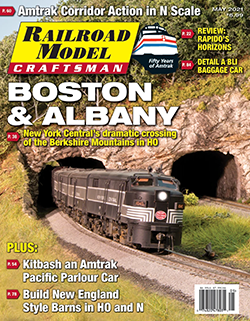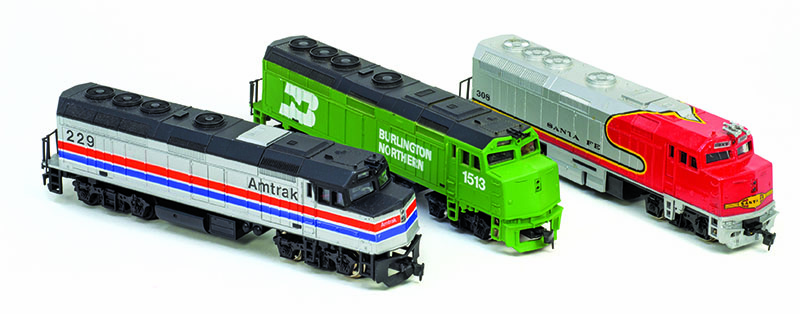As a kid, I followed the development of Amtrak with great excitement. The government-created passenger carrier is almost exactly five years younger than me, and this was always, and continues to be, a railroading subject that commands my attention. Among the equipment associated with Amtrak, Electro-Motive Division’s (EMD) F40PH is an iconic member of the service’s history. For me, Amtrak’s F40PH diesel locomotive was important and serves several noteworthy milestones in my hobby experience.
The “rainbow era” of the early 1970s brought some amazing equipment across the Chicago-to-St. Louis corridor, where my dad and I most often spotted Amtrak trains in those first years of the service. Exotic delights such as Great Northern “Big Sky Blue” dome cars that had trekked across the Rockies were now plying the prairie and serving in Abe Lincoln and Ann Rutledge consists on the Illinois Central Gulf and seemed like visitors from another planet.
I had much anticipation for what motive power and passenger cars Amtrak would acquire. I knew of Budd’s racy Metroliner and thought it would be the look of the future and what I expected Amtrak to be like when it had its own equipment. Bachmann’s HO-scale Metroliner, introduced in the early 1970s, was an early Amtrak purchase for my own roster. On a trip to Springfield, Ill., I dumped a jar of coins out on a counter at a Woolco store to pay for my example (to the surprise of my dad and the horror of the cashier).
Within a few years, information began circulating in the railroad press about Amtrak’s equipment purchases. The result was the mid-1970s arrival of EMD SDP40F and General Electric (GE) P30CH diesel locomotives, followed soon after by Budd Amfleet I passenger cars. After the amazing French-built Turboliner staked a claim on the Chicago–St. Louis corridor (see HO Collector’s 2nd Quarter 2021 issue for a look at Jouef’s HO replica), new power and passenger cars appeared with P30CH units pulling what looked like headless Metroliners (new Amfleet cars). The flat-nose P30CH riding on six-axle trucks seemed like a massive brute of a locomotive to me, and I also got to see the equally big SDP40Fs working on Santa Fe’s rails in northern Illinois. So, this is what Amtrak power will be… or so I thought.
The troubled history of EMD’s SDP40F is well-known, and I will not go into it here, beyond stating the unit’s shortcomings helped bring about the four-axle GP40-2 variant known as the F40PH diesel locomotive. While I liked the six-axle SDP40F and P30CH, something about the sharp, angled lines and design of the F40PH won me over; though I believe I may be in a minority (or at least I was back when they were new and becoming the standard power for Amtrak).
Between newly built F40PH units and recycled SDP40Fs (F40PHR), Amtrak soon had a sizeable collection of these 3,000-hp units. Envisioned as the locomotive for short-haul or corridor services, with only 25 examples of GE’s P30CH and the issues with the 150 EMD SDP40Fs, the F40PH was soon called on to take the reins of long-haul services like Amtrak’s Empire Builder and Broadway Limited runs, after the downfall of the SDP40F and no additional orders for P30CHs. This dual service made Amtrak’s F40PH units the standard-bearer and a de facto face of the rail passenger carrier from the late 1970s into the 1990s.
Bachmann, Life-Like, and Pemco all offered F40PH models early on painted for Amtrak and other railroads that didn’t have the locomotives.
First F40s
With its nationwide status and growing numbers, a mass-market model of the F40PH was a sure bet. In the late 1970s, I had hopes of a “blue box” HO-scale model from Athearn; however, that was not to be. Upstart hobby maker American GK announced Amfleet cars and motive power, which included a proposed plastic HO GE P30CH in the late 1970s. Difficulties led to American GK’s output is much more limited than planned and that fabled P30CH did not make it to market (HO Collector’s 1st Quarter 2019 edition’s cover story “Cancelled Trains” presents American GK’s troubled tale).
What did come to HO was a trio of basic F40PH diesel locomotive releases for the ready-to-run market. This seems to confirm a long-held assertion of mine that in the hobby we have no example of a particular prototype until we have at least three available! The participants in the three-way F40PH race were Bachmann, Life-Like, and Pemco, and all examples saw release within a few years between 1977 and 1980. As noted, these plastic HO F40PH offerings were aimed at the “train set” market. However, the lack of a high-quality reproduction led to these shells being the source for many a craftsman taking them and making respectable, detailed, and well-running F40PHs for HO Amtrak service.
Considering when tooling work commenced (as EMD production was getting underway), it is no surprise that these F40PH renditions generally represent early production or Phase I bodies. Though I’ve reacquired hundreds of magazines and catalogs as an adult that I enjoyed in my youth, a 1983 copy of Mainline Modeler has survived in my collection since it was purchased new from a hobby shop. That June edition featured Robert J. Zenk’s “Electro-Motive’s F40PH: The Three Phases of Amtrak.” This article was my first serious exposure and cultivated my interest in production phases. Between the prototype photos and Robert Hundman’s drawings of F40PH units showing three production phases variations, this magazine article is a great reference item for the Amtrak fan. It was in this presentation that I discovered button-top fans have no place on an accurate F40PH, as well as other important attributes of these four-axle locomotives.
Soon after Mainline Modeler’s 1983 survey of prototype F40PHs, the June 1985 Railroad Model Craftsman featured a how-to on modeling this Amtrak locomotive. Bill Manzke’s “Today’s F’s: Modeling the F40PH” showed how to improve Life-Like’s model and sustained my interest and desire for a superb HO replica. The article opens by stating, “The locomotive that most universally represents passenger railroading in the 1980s is probably EMD’s F40PH.”
Those early plastic F40PH models are a mixed bag with respect to quality and accuracy. I would judge the general level of quality to be good to maybe slightly better in comparison to the average HO diesel work of similar offerings in this entry-level category. Bachmann and Life-Like shells are Phase I examples; this can be most obviously spotted by position of the tank ahead of the rear truck. Later F40PH production swapped these and put the tank behind the lead truck. There are many other variations and spotting features, but that one is an easy demarcation between the early F40PH (Amtrak 200–229) and later examples beginning with Amtrak 230. The fidelity of Life-Like’s tooling made it the more preferred starting point for series models. For example, Front Range produced a chassis and drive mechanism and it either provided a Life-Like shell or was made to best fit this version of F40PH body. I recall having an early Amtrak F40PH from Life-Like and becoming frustrated with its performance, and put a Roco-made drive from an Atlas GP40 under it at some point… I don’t recall how I arranged its coupler ability on the back, but I did.
A footnote to these original F40PH units is Pemco’s offering in 1980. When this model debuted both Bachmann and Life-Like had been selling HO-scale F40PH diesels for a couple of years. Pemco’s model copied Life-Like’s tooling, though there is at least one curious detail addition present on Pemco’s F40PH (a pair of classification lights located on the lower outer corners of the nose). Among these early F40PH efforts, Amtrak was the obvious and most common road name. In addition, Chicago’s Regional Transportation Authority in light blue was offered by Bachmann and Life-Like. Amortizing the tooling, you will also find several fantasy road names including Santa Fe from Bachmann, Rock Island from Life-Like, and Burlington Northern from Pemco. While Amtrak was accurate for this locomotive, Pemco produced a red-nose Phase I scheme that was never applied to an F40PH. I have also encountered Bachmann-made F40PH models with this early Amtrak livery (though you won’t find them cataloged and I’m uncertain of when they were offered or how prevalent they were, but they seem uncommon from my experience).
The other F40PH to mention from this era would be the proposed HO scale model from American GK. While some of that company’s other pieces made it to the mock-up stage, a stand-in F40PH appears as close as this effort may have come. American GK prepared release announcements for its F40PH, which included a slightly modified Life-Like model. The mock-up model includes paint to hide the slots in the lower body shell for snapping in a frame, includes a later number (Amtrak 253 versus Life-Like’s 229) and flipped the tank orientation between the trucks to mimic a Phase II (Amtrak 230–328) body. Beyond those noted revisions, this model looks to be a stock Life-Like F40PH. The stand-in was used for publicity since American GK’s own model was months away from tooling or production.
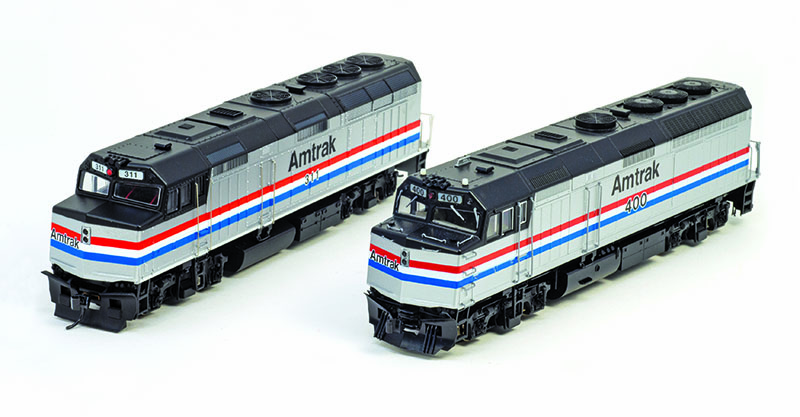
The next generation of F40PH models came from Walthers and Kato in the 1990s. It was starting to seem as if we had reached the peak for F40 models, but there was still more to come.
The Next Generation
In the 1980s, I felt the F40PH was possibly oversaturated in the HO marketplace with Bachmann and Life-Like products available, and to a much lessor extent Pemco’s minor run, and it seemed a great reproduction F40PH was not to be for 1:87. Around 1990, Bachmann introduced its Spectrum series. The line debuted with new tooling efforts which presented a Pennsylvania Railroad K4 steam locomotive, General Electric’s 44-ton center cab diesel switcher, and an upgraded EMD GP30. The same enhancement process was given to Bachmann’s F40PH shell for its early 1990s Spectrum reintroduction. The body shell saw better rooftop details with the basic see-through fans replaced, though the new ones were button-top variety that are not accurate to my knowledge. Separate wire grab irons replaced molded-on plastic representations, working strobe lights were added to the cab roof, and a new flywheel drive mechanism with all-wheel power made for an improved runner. Certainly, it was the best F40PH in plastic on the market at the time.
I had begun learning to airbrush and decal in the early 1980s. My dad had always been able to reproduce great looking models and I wanted to try my hand at this process. One of the models that served me well was Bachmann’s F40PH. When I first got a credit card, I ordered three Bachmann units from New York’s famed TrainWorld hobby shop. I stripped the Amtrak livery and custom-painted them into fantasy roads, including Norfolk & Western and Southern Pacific. The later Spectrum release came along as my paint and decal skills had advanced and I did a Rio Grande F40PH in the road’s Aspen Gold-and-silver and numbered it right after the last F9s at 5775. Years later, the Ski Train would operate F40s in similar livery.
The next new F40PH in plastic came courtesy of Walthers and its Trainline series. Introduced in 1998, Walthers’ effort was the second all-new tooling locomotive for this product line (the first was an EMD GP15-1) and presented a later phase F40PH with tank in the forward position. The model’s fidelity was quite good and upgrading it with separate wire grab irons could be done thanks to the lack of molded-on detail. This was another F40PH to serve as a milestone for my modeling, as drilling and adding grab irons was something I was practicing more and taking an interest in. While this was a better F40PH, I still didn’t think this model had received the treatment it deserved.
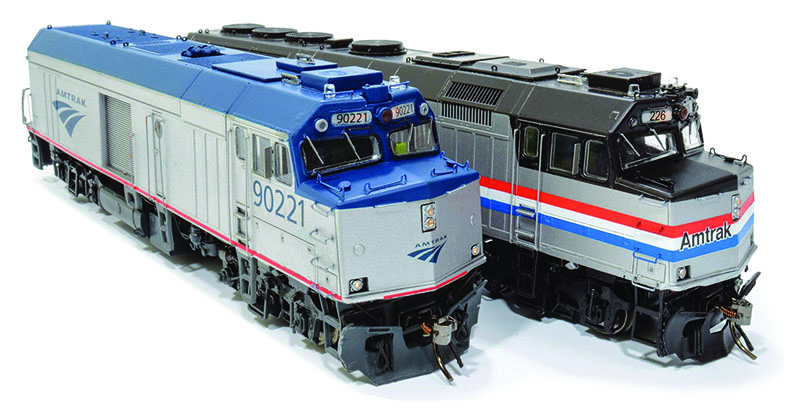
“The most awesome F40PH ever?” was the question asked by Model Railroad News when Rapido released its own version of the iconic locomotive.
Fine Scale for the Future
In the mid-2000s, Kato announced their F40PH release in HO scale. This was for sure to be the quality level I’d wanted to see in a model of this prototype. In typical Kato fashion, the 2005 first-run F40PH was a great-looking piece. The model’s drive was that unquestionable smooth performing Japanese-made motor, and the shell looked good and came with separate plastic details to install.
Again, a milestone for my own modeling work, this Kato release was the first locomotive where I installed a Digital Command Control (DCC) decoder and sound unit. If I remember correctly, I put in Model Rectifier Corp. electronics that were new or recent at the time.
I was pleased with this model and had a pair of Amtrak units in my collection. Kato’s F40PH was a later production (Phase III) variant spotted by the forward fuel tank and countersunk Q-type radiator fans on the roofline. That first DCC-sound install racked up countless miniature miles pulling Superliners. For the serious spotters, Kato’s F40PH gets some knocks for the length of the nose (it is a tad short).
After Kato’s F40PH, I thought the prototype had been well-served in HO scale. By this time, Amtrak’s GE P40/P42 “Genesis” diesel locomotives were the face of the service and had been for most of a decade. The F40PH’s prime days may have been behind it; however, its best days were still ahead in HO.
In 2016, Rapido Trains delivered its first production of HO scale F40PH diesel locomotives. April 2016’s Model Railroad News cover asked, “The Most Awesome F40PH Ever?” The company had already produced a VIA Rail F40PH-2D about a year before in 2015 and these Amtrak releases were stellar and well worth the wait.
Rapido Trains revisited this prototype a few years ago with modernized F40PH units featuring ditch lights cut into the nose (per prototype) and repurposed “Cabbage” or NPCU examples. Rapido Trains’ HO scale F40PH is a Phase II body (including the IIb with ditch lights variant) and packs an amazing level of detail, accuracy, and performance. As you read this, Ski Train F40PH models should be available, along with Boston MBTA silver and purple units and NJ Transit offerings, all with road-specific details and trim.
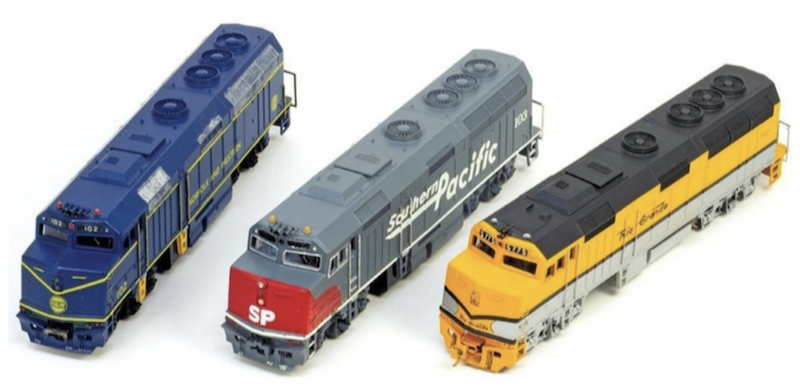
Author Tony Cook used the then-new Bachmann F4oPH in the 1980s to try painting and lettering. In this instance, he painted F40s for the N&W, SP and Rio Grande (Before one was painted in that scheme in real life for the Ski Train).
Hobby Milestones
It was not until I began preparing this column that I realized the many times an F40PH was an important milestone in my own hobby experience. From learning to paint and decal to adding details to installing DCC and sound, the F40PH in one form or another was with me at each step of the way. My collection includes examples of all the plastic efforts produced over the years and a Pacific Fast Mail brass late-1980s release that was my last big purchase from Caboose Hobbies in Denver.
While I’ve briefly presented the F40PH here, there are examples in other scales as well as additional points of interest for HO worthy of mention. Over the years, I hope this locomotive was special to other modelers, and brought them some of the fun moments as the F40PH has for me.
Tony Cook is editor of White River Productions’ Model Railroad News magazine, and co-editor of HO Collector quarterly.


